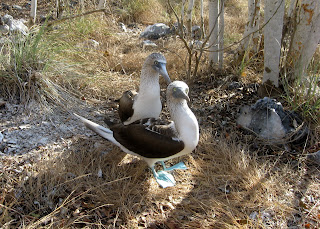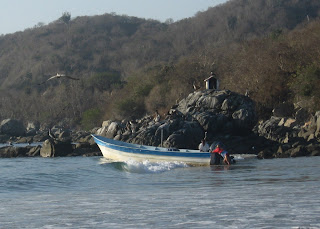Tuesday, April 7th - Our Savor Day in Playa La Bonanza was much enjoyed. The only minor negative was the filet from the large Mexican Tunny we had caught the previous day. (At last, we now have properly identified it and can give it a name.) The First Mate cooked it for lunch, and as we both suspected, its dark red meat had a heavy, gamey taste that, politely stated, was not to our liking. The remainder went over the side. Silently, The First Mate asked King Neptune his forgiveness for having killed and then not appreciated one of his offerings to us, but, no matter what King Neptune might think, we have decided to return to the sea any more such fish we catch. Dorados are another matter. For the Dorado we caught on the way into Bonanza, The First Mate thanked King Neptune profusely.
Wednesday, April 8th – We arrive in La Paz in the late morning, timed to catch the rising tide. The harbor of La Paz is a big, wide-open bay, deceivingly riddled with sand bars and shoals. To get to the anchorages and marinas on the city side of the bay, one has to navigate the narrow Canal de la Paz which is said to be dredged to a least depth of 12’. Wander off this channel, and you will be embarrassingly stuck in a muddy shoal out in the wide open for the whole La Paz viewing public to see. Fortunately, the channel is well buoyed. We enter slowly, watching the depth meter. At a particularly narrow section, it drops to 12’, but not much under that. Arriving at the entrance jetty of Marina Palmira Yacht Club, where we have a confirmed berth, we enter. Here, too, we watch that depth meter, slowed to a crawl and prepared to go into a quick reverse when depths show 10’ in one section. Marina attendants await us at our slip. The First Mate turns Avante around and backs into the berth, earning Avante a compliment from the captain of a neighboring boat. “She sure backs down nicely.” Yes, she does!
Del and Dave Rowley, friends from Scottsdale, will arrive in town later today, driving up from Cabo San Lucas with a rental car. We will, therefore, have a car in La Paz. How delightful! As with all our boat guests, we had asked them to make hotel reservations for their first night just in case we are delayed for some reason. The Captain and The First Mate spend the afternoon giving Avante a much needed fresh-water wash down and cleaning. Then we give ourselves a much needed fresh-water wash down. Laundry is done by a woman who comes to the boat to pick it up and then returns it 2 hours later, neatly sorted and folded. “What a nice service”, thinks The First Mate and wishes someone would always show up at the boat every time they pulled into a marina with an offer to do laundry.
At 6:00pm, we take the marina shuttle into town and are dropped off one block from “Casa Tuscany”, the Rowley’s cute Bed and Breakfast inn. We walk to “Las Tres

Vírgenes”, a restaurant recommended by the owners of the inn. There we sit in an outdoor courtyard and watch our food being cooked either in a wood-burning oven, something The First Mate has been trying to talk The Captain into building for her out on the ranch, or over a grill in an outdoor fireplace, another culinary preparation she has been meaning to try in the fireplace on the ranch’s porch. What a delicious meal we enjoy sitting under the stars with conversation tinged by the excitement of the trip ahead!
We spend the next day provisioning. Though the list is not a long one, provisioning in a new port-of-call is always a challenge. Can you find what you want? If not, can you do without or will something else substitute? What is this strange looking vegetable? How does one cook it? Well, I’ll just take it home to Avante and see what the cookbooks say! If a local Mercado is near and open, The First Mate will go there first, for that is where the freshest produce can be found, as well as the best prices. Most often the Mercado is inside a huge open building with various vendors setting up shop in individual stalls. Produce spills out in tempting displays.

If you arrive at the Mercado hungry, there are vendors of food and delicious fruit drink concoctions to fill that need. The Mercado is a place full of life, color and local flavor.
Our shopping trip takes us first to the local Mercado for fresh produce and then to 2 larger supermarkets for the non-perishable items. Even with the rental car to get us where we need to go quickly, it takes the better part of the day to locate and purchase everything we need or want. With the provisioning done, on the boat and stored, we are ready to leave the next morning. That night we dine at “Las Tres Vírgenes” again – no sense wasting a good find!
The Rowleys are enthusiastic people and have done a good many adventurous activities, but they have never spent a full 24 hours on a small sailboat. They have listened to our explorations on Avante and have been reading this blog. Noting that we have always returned from wherever we went and being trusting souls and good friends – they decide to take us up on our invitation to join the adventuring. They have signed on for six days in a very popular cruising area around the islands north of La Paz, and we all think that is a fair experiment for their first time cruising on a sailboat.
Friday, April 10th – Del and Dave arrive at the dock, stow their gear, and receive The Captain’s safety briefing. The importance o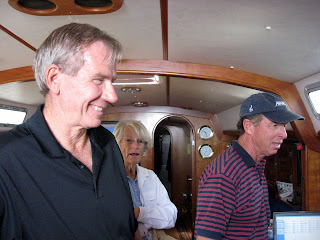 f water conservation on a boat at sea is discussed. Proper head usage techniques are explained, prompting some trepidation on Del’s part and laughter from all of us. We do have a somewhat complicated system for the aft head. Both heads on Avante are vacuum flush units which mean one only needs to step on a pedal to flush -- a great improvement over the traditional marine head with its hand-pump system. The aft head, in addition to being a vacuum flush, also has a Lectra/san unit, a system that combines electric current with salt water to “fry” waste and sanitize the stuff coming out of the boat. When using the “fryer”, one needs to step on the flush pedal, wait 3 seconds, then push a button on the “fryer” control making sure the correct little light goes on. In addition, prior to flushing, one needs to verify that a valve has been turned in the right direction depending upon whether we are at sea or at anchor or in dock. It really is not complicated unless one is totally new to the system. We have discovered that some of our guests understand the procedure right from the start, some take a time or two to figure it out, and some never quite get it. Del and Dave fall happily into the first two categories.
f water conservation on a boat at sea is discussed. Proper head usage techniques are explained, prompting some trepidation on Del’s part and laughter from all of us. We do have a somewhat complicated system for the aft head. Both heads on Avante are vacuum flush units which mean one only needs to step on a pedal to flush -- a great improvement over the traditional marine head with its hand-pump system. The aft head, in addition to being a vacuum flush, also has a Lectra/san unit, a system that combines electric current with salt water to “fry” waste and sanitize the stuff coming out of the boat. When using the “fryer”, one needs to step on the flush pedal, wait 3 seconds, then push a button on the “fryer” control making sure the correct little light goes on. In addition, prior to flushing, one needs to verify that a valve has been turned in the right direction depending upon whether we are at sea or at anchor or in dock. It really is not complicated unless one is totally new to the system. We have discovered that some of our guests understand the procedure right from the start, some take a time or two to figure it out, and some never quite get it. Del and Dave fall happily into the first two categories.
Feeling that enough information has been dispensed for the moment, we set off to explore the Sea of Cortez. Our intended anchorage is one of the coves on the northwestern end of the Isla Espiritu Santo or Isla Partida, about 20nm away. Winds are light, but we are able to sail for a few hours.
We anchor in Ensenada el Cardonal, one of several popular anchorages on Isla Partida and head ashore to follow a trail through a canyon. The trail borders a mangrove marsh and leads to the other side of the island.
It is said that cruising the Sea of Cortez is like “sailing in the desert”. As we walk across the crumbled volcanic soil of the island, we have no doubt of that. It is dry and hot as we hike inland from the water. Cactus and other prickly plants are abundant and similar, though often just a bit different from the ones we know from Arizona. The Saguaro of Arizona does not grow at sea level. Instead, there is the Cardon which looks very much the same.
Back on Avante, we set about making dinner and afterwards enjoy sitting on deck before the evening chill caused by a freshening breeze drives us below.
We soon become aware that breeze has become wind, and the wind is building. The boat, too, has begun rocking and rolling with the increased wave action caused by the wind. At 2145 (Captain’s log), as we are all thinking about settling in for the night, a big wind gust howls down the bay we are anchored in, slams against the boat and then continues across the island funneling through that canyon we had hiked. The Captain goes above to check out how Avante is sitting. As he is monitoring the scene, the anchor alarm goes off indicating that our position has altered, either due to a change in wind direction or because the anchor is dragging.
Earlier when we were anchoring, The Captain was talked into a shallower anchorage than he normally would have chosen by The First Mate, who wanted the more picturesque setting of being nestled in closer to shore for the Rowleys’ first night on Avante. The bay shallows out a long way from the shore, and we appeared to still be only part way into the bay when The Captain started to anchor at 25’ of depth. Reluctantly, he acquiesced and moved in closer to shore to a depth of 15’. At anchoring time, winds and seas were quiet, and an expected full moon would cut the darkness of the night if anything did happen. Now, the strong wind and building seas, coming straight down the bay, threaten to push us toward shore, and we do not have a lot of distance before our 9’ keel would hit bottom. When winds are heavy, (and when anchored further out) we normally let out more anchor chain, but now we have no room to do that. We have no choice. We have to move the boat and re-anchor in the howling wind, the bouncy seas and the dark (full moon or not, it’s dark). Quickly all hands scramble on deck. The engine is started. The Captain starts pulling up the anchor. At the helm, The First Mate sees 12’ on the depth meter. Even though the anchor is still being raised and not back on the boat, she engages the engine to keep Avante from sliding back further into the shallows. We head out into the middle of the bay to re-anchor. We are not successful the first time. When we back down hard on the anchor to ensure that it is well set, the anchor begins dragging in the soft bottom. Up comes the anchor, and we motor to another location to try again. This time the bottom is firmer, and the anchor bites in and holds. We all let out a sigh of relief while The Captain lets out some more anchor chain for extra security. This exercise was not fun. The First Mate decides that never again will she push for a closer to shore anchoring location. At the same time, she wonders if Del and Dave are wondering if this cruising was such a good idea after all!
Though we are safely anchored, it is not comfortable. Winds are strong and the boat is rocking and rolling on the choppy seas. The anchor alarm is set and explained, and with that reassurance, we all head for our berths. For the rest of the night, the winds continue to blow. Sometime after midnight, they drop to about 15 to 20 knots, and The Captain and First Mate hope things will start to settle down, but an hour later, they are back up to 25+ knots. These are the nighttime Coromuels, the “gentle breezes unique to the La Paz” area”. The Captain and The First Mate sleep lightly and watchfully. Even with that anchor alarm, we keep an eye on things. Nights like this do not happen often, but we have learned to keep alert and ready to take action if necessary. Del and Dave endure an interesting first night on Avante. They did not know a boat could make so much noise or bounce and roll from side to side so much or how difficult it was to uncurl oneself and climb out of an unstable aft berth in the middle of the night. To our relief, they show up in the morning laughing and eager to start the day. Cappuccinos and breakfast are served.
Morning light came with lower winds, but they are still well into the teens. The churned-up seas have Avante rocking from side to side. No one would have called the winds of last night “gentle” or this anchorage restful. To The First Mate, the blow created by these Coromuels was totally unexpected, and she wonders just what she missed in her reading of the cruising guidebooks. She does not remember reading anything noteworthy about these winds other than that they occur occasionally during the spring and summer and are found in the La Paz area. She gathers together the three Mexican cruising books they have aboard Avante to re-read. According to “Sea of Cortez”, one of the cruisers’ guides, “the cause of these winds results from the low land southwest of La Paz, which allows the cool air from the Pacific Ocean to flow across the Baja peninsula to the warmer Sea of Cortez”. These winds, therefore, blow from the south or southwest, but why be concerned about an occasional “gentle breeze” that helps cool things down? Reading further, she does find one mention that they can sometimes cause navigation problems. “Navigation problems” is not explained, but whatever they are they are not caused by a “gentle breeze”. A further hint shows up as she looks at the descriptions of the anchorages around the greater La Paz area. All guides talk about the wind protection of any anchoring spot, but one guide specifically mentions Coromuel protection as in “bay is open to the west and southwest, therefore there is no protection from night time Coromuels”. The First Mate quickly realizes that she let herself be duped by thoughts of “gentle breezes” and did not then pay attention to other clues that tell a different story about Coromuels. A bit miffed, she decides that if she were writing one of these guidebooks, she would not mince words ----
“Beware and be warned. These may be gentle breezes in La Paz, but out on the islands, they are heavy-duty winds that can dislodge well-set anchors and cause extremely uncomfortable seas. They start in the late afternoon to early evening. They howl all night. No need to ponder a peaceful night’s sleep. It will not happen. They don’t just arrive, swirl around nicely and peter out. No, they are looking for an outlet. Any bay or cove facing west is a target. Pick such a cove, especially one with a canyon or low-lying area at the end of it, and you have my pity. The Coromuel has now found an outlet. It will whistle into your bay, significantly increasing in intensity as it funnels in and thru the narrow walls of the canyon. You have effectively anchored in a wind tunnel. Not the best of decisions, but a hard one to avoid on the islands north of La Paz where 90% of all recommended anchorages are exposed to the west and vulnerable to the nighttime Coromuels. Good luck, or, as they say down here, ‘Ve con Dios’.”
All aboard Avante are eager to be on the move rather than rolling around at anchor. We motor out of the bay, then raise sails and enjoy a brisk sail over to Isla San Francisco. The Captain, anticipating another round of nighttime winds, chooses to anchor in an east-facing cove that looks like it should offer more shelter from anticipated Coromuels. The Dingbat is launched, and with beach towels and books in hand, we hike across a dry lake to a cove on the west side of the island. There an expanse of white beach beckons.
The Captain relaxed – at last! Warm sand, great book and a nap.
The big question for tonight is The Coromuels. Will they arrive? When will they arrive? How strong will they be: gentle breezes or howling tempests? Not wanting to keep us guessing, they are up by the time we return to The Dingbat. Wind-churned seas are up, too. Thus, an interesting time is had by all as we launch into the rolling surf. First one on gets to haul the next one on. It’s a comic scene (which most boat launchings are down here), but we are all on and afloat. Engine starts. Great! Off we go. Bashing thru the waves back to Avante proves to be a cold, wet experience, especially for the gals sitting in the bow of The Dingbat.
The Captain’s choice of anchorage is a good one. We are protected by the high ridge in front of us, Therefore, Avante is not rocking and rolling quite as much – though it is anything but a quiet anchorage with plenty of noise caused by waves slapping the sides of the boat, things creaking, and taut lines vibrating. Again, Del and Dave show up in the morning smiling, laughing and cheerful. Dave announces that he has figured out which side of the berth is best for him to sleep on and how to uncurl his 6’+ body out of the bunk without having to wake Del so she can get up and out of the way first. His cleverness and resourcefulness are praised. Both such attributes go into the making of a good sailor.
Sunday, April 12th – Easter morning. We are all up early enjoying a moon still visible and not yet dimmed by the rising sun. We watch the sunrise, admiring the colors in the rocks as they sharpen in the growing light.

There is an interesting ridgeline hike at the end of the bay which we decide to do before breakfast.
Armed with water bottles and hiking shoes, we set off in The Dingbat.
We scramble up a narrow trail of loose and crumbling volcanic rock. It is slow going, but we are all determined to get to the top.
The view of Avante in the bay below is impressive.
Note the well turned-out Avante “crew” standing atop the ridge with The First Mate. Light Blue “Avante” shirts and “Avante dark blue caps. No doubt about the capable hands keeping her afloat!
The trail becomes much easier when we reach the ridgeline.
Our reward for the effort is a fantastic view of the east and west bays separated by a narrow isthmus of salty sand.
The First Mate is impressed that a bush can find enough moisture on this dry, wind-blown height to put forth this bright red flower.
Back on Avante, we treat ourselves to Clamdiggers and a robust breakfast of egg and sausage burritos. Later in the afternoon, we pull anchor to head over to the opposite bay or the Hook, as it is called, on Isla San Francisco. The Captain has been monitoring wind reports, and it looks like this anchorage will work for tonight – plus it is prettier. Winds are up to 15 – 20 knots as we motor around the point to the western bay. This is great sailing weather, but with only a couple of miles to go to get around the point, we decide to just motor. It is still blowing when we anchor, but eventually winds diminish enough so that we enjoy a much calmer night. Maybe, just maybe, our bout with the Coromuels is past. Del and Dave are up with laughter and smiles in the morning. Yes – these two are turning into good sailors!
Monday, April 13th - Laguna Amortajada (Shrouded Lagoon), the largest mangrove lagoon on an island in the Sea of Cortez, is located near the southern tip of Isla San Jose. Though anchoring in the shallow waters with shifting sand bars is tricky, we read that the dinghy trip thru the lagoon with all its interesting wild life is worth the effort. We decide to motor over to this island and anchor for a couple of hours while we launch the dingy and explore. The weather is calm as we set off. In about an hour, we are entering the bay of the lagoon. The turquoise water extending out from the shore clearly shows where the shallow waters are. We enter slowly, circling around our anchoring spot to verify depth. We drop the anchor and slowly back down on it. It catches, holds and then releases, slipping thru the muck before finally catching again and holding securely. Unfortunately, this now puts us too close to the shallow edges where Avante might be pulled if wind or current change direction. We lift the anchor and move further out to try again. However, the water gets deep quickly and we are now trying to anchor in 50 to 60 feet. Three times we try with growing frustration. Each time, the anchor just will not catch and hold. While we are intent on this anchoring exercise, we are mindful of a rising wind. After the fourth attempt, a serious look at the winds, which were now up to 18k, tells us that good anchor set or not, there is too much wind and too much shallow water nearby for us to be able to leave Avante unattended and go venturing forth in the dinghy.
Disappointed, we head across to San Evaristo, a sleepy little fishing village, where we plan to anchor for the night, consoling ourselves with thoughts of the fresh fish we are going to buy from the local fishermen. The bay of San Evaristo contains 2 lobes. We would like to anchor in the smaller, more picturesque one. Though there are several boats already at anchor, we do see a spot for Avante near the entrance to the cove. We head in and drop the anchor in 60 feet of water. It sets nicely, but as we sit watching Avante swing in relation to the other boats around us, we realize that either a strange current or wind pattern caused by the curvature of the steep rock walls of the bay has us swinging too close to another boat. It would be fine if that boat were swinging away from us as we were swinging toward it. This is what usually happens at anchor, but not here. All the boats appear to be moving in different directions – all in response to either that wind or current which we cannot see or feel. Whatever is at work, this will not do. Up comes the anchor again. We certainly are paying anchor dues today! We head into the larger lobe of the bay directly in front of the town’s beach. Our first attempt to anchor here is stymied by the anchor skipping over rocks, but finally we have a good set. Triumphantly, The Captain gives it a thumbs up approval. Shut the engine. Let’s launch The Dingbat and go buy our fish!

On shore with a successful dinghy landing, we are greeted by a parade of pelicans.
We find the person selling fish and chose a healthy looking Sea Bass. The Captain is happy to have someone else cut up the fish. We are all impressed by this man’s skill with his knife! Took no time at all to cut, skin and de-bone our filets with that instrument.
Just to make sure that we do get lulled into complacency, the Coromuels come whistlin g in later in the evening. San Evaristo is located on the Baja coast and with the dramatic Sierra de la Giganta mountain range rising above the beach, the bay is one of the few anchorages around here that does offer some shelter from these winds. Gusts are well up into the teens, but as they are blowing out to sea, they are not as threatening nor do they seem to have quiet the same punch. Sheltered or not, punch or not, it is still a rocky night. At one point, both The Captain and The First Mate go up on deck to check things out. This is part of our normal nighttime routine. Get up, hit the head, check out the boat. Del, whose aft berth is near the cockpit stairs, hears noises on deck. Peeking out her portal, which looks into the cockpit, she sees feet. Whose feet? Where did they come from? Feeling sure we have been boarded by pirates, she stealthily gets up without waking David, locks their door and creeps back into bed. A lot of help she would have been if there had really been pirates! Next time we’ll give her the foghorn whose blast is enough to wake the dead. She can blast that from inside her locked stateroom. We all get a good laugh out of that story because, mainly, we know there are not any pirates off the Baja coast. The First Mate decides that for Crewman Del, after surviving these wild nights at sea with an occasional loose anchor, what are a few pirates? Bill and Sue can handle the boat; they can handle the pirates, too! The First Mate appreciates the confidence, but thinks that she might have locked her door, too, if she had heard pirates stomping around above her head!
g in later in the evening. San Evaristo is located on the Baja coast and with the dramatic Sierra de la Giganta mountain range rising above the beach, the bay is one of the few anchorages around here that does offer some shelter from these winds. Gusts are well up into the teens, but as they are blowing out to sea, they are not as threatening nor do they seem to have quiet the same punch. Sheltered or not, punch or not, it is still a rocky night. At one point, both The Captain and The First Mate go up on deck to check things out. This is part of our normal nighttime routine. Get up, hit the head, check out the boat. Del, whose aft berth is near the cockpit stairs, hears noises on deck. Peeking out her portal, which looks into the cockpit, she sees feet. Whose feet? Where did they come from? Feeling sure we have been boarded by pirates, she stealthily gets up without waking David, locks their door and creeps back into bed. A lot of help she would have been if there had really been pirates! Next time we’ll give her the foghorn whose blast is enough to wake the dead. She can blast that from inside her locked stateroom. We all get a good laugh out of that story because, mainly, we know there are not any pirates off the Baja coast. The First Mate decides that for Crewman Del, after surviving these wild nights at sea with an occasional loose anchor, what are a few pirates? Bill and Sue can handle the boat; they can handle the pirates, too! The First Mate appreciates the confidence, but thinks that she might have locked her door, too, if she had heard pirates stomping around above her head!
Tuesday, April 14th – Today we begin the return trip to La Paz. Plans are to sail south to Caleta Partida, the bay between the two islands of Espirito Santo and Isla Partida. We are not particularly excited about another night at these islands, but the distance to an alternative anchorage would mean a marathon day. We motor out at 8:30 in light 5 knot winds, have breakfast on deck and by 9:45 are able to raise sail in a brisk 15 -18 knots. We tack past Isla San Francisco where we hiked the ridgeline trail several days earlier. Later that afternoon in lessening winds, The Captain decides to give his crew some lessons in tacking. The Firs t Mate enjoys watching Del and Dave go thru the same trials and tribulations that she endured not so very long ago. Which way does the winch turn? Which way does the rope (no, halyard or is it sheet?) go around the winch? When do I let go? Which button to push? When? What do I do now? And above all, keep your hands clear! The crew is quick to learn, and we soon graduate from a 3-knot tack to an 8-knot tack as the wind picks up again.
t Mate enjoys watching Del and Dave go thru the same trials and tribulations that she endured not so very long ago. Which way does the winch turn? Which way does the rope (no, halyard or is it sheet?) go around the winch? When do I let go? Which button to push? When? What do I do now? And above all, keep your hands clear! The crew is quick to learn, and we soon graduate from a 3-knot tack to an 8-knot tack as the wind picks up again.

With the increase in wind, The Captain adds a lesson in helmsmenship. Dave steps to the helm and quickly catches on to the affect of wind on sails and the reading of the various instruments.
Realizing Dave has got it, The Captain leaves the helm, and Dave is on his own up there.
By 4:00, we are at the entrance to Caleta Partido. By 4:20, we are anchored in the southeast section of this western facing bay based on the advice in one of our guidebooks that “some boats choose to anchor in the southeast portion of the cove to help lessen the Coromuel wind effects.” It was relatively calm outside the bay, and we are hopeful. The calm conditions outside do follow us in, but they don’t last long. The Coromuels are arriving! Our plans to launch the dinghy to explore ashore are stymied by the mounting winds. White caps now surround us, temperatures have dropped, and no one is interested in a bouncy, wet dinghy ride.
It is our last night together aboard Avante, and the Coromuels give us their best. They howl all night from the west, barreling into our bay then crossing the low land at the head of the bay and blowing out into the Sea of Cortez. We regularly see 25 – 30 knots with an occasional 35-knot gust. It is going to be another wild, rough night. Anchor alarm is on. Wind velocity meter is on by the owners’ berth for us to monitor. We are ready for the night.
The Coromuels continue at full blast for the entire night. At 1035 in the morning, as we raise anchor and motor out, the wind in the anchorage is still at 15 – 20 knots. When we exit the enclosing walls of the bay, winds begin to drop. By the time we are out of the bay, winds are down to a benign 10 knots. As we sail down the west coast of Isla Espiritu Santo, we take a good look at the island and fully understand the how and why to these Coromuels out on Espiritu Santo and Isla Partida. Both of these islands are steep and mountainous, and these mountains block the Coromuel winds from blowing across the Bahia de La Paz to the Sea of Cortez. They do, however, have a number of canyons cutting deeply across from one coast to the other. That is where the winds will go. Each of these canyons, with their narrowing walls, compresses and accelerates the wind causing the Coromuels to howl thru any bay and anchorage at its base. Mother Nature’s natural wind tunnel at work! Where are all the lovely anchorages that the guidebooks recommend? In those same bays and coves leading into the canyons. What the guidebooks do not say is “Beware the winds during Coromuel season.” When is Coromuel season? Spring and Summer. The Captain and First Mate have learned by first hand experience and will be prepared if they do return up here again. The First Mate, who has finally begun to think of herself as a sailor, wonders what it would be like if the Coromuels blew out here during the day, all day! What would a full day of constant, steady high wind be like? When, where does that happen? On the way to the Marquesas? Hmm-m-m-m?
We are able to sail most of the way to La Paz, though we do spend the last hour motorsailing in winds around 5 knots. (Never saw 5 knots last night!) We motor down the channel to the marina. Marina hands are once again there to help with the lines.
The next day we all take a private tour of the city. The First Mate is eager to see the museum which is supposed to have well-done and informative exhibits of the early inhabitants of the peninsula and of the cave paintings found up in the Sierra de la Gigantas. She has been fascinated by descriptions of them in her reading of “Almost an Island” by Bruce Berger. She would like to see these paintings for real, but the ones she wants to see require a multi-day mule or donkey ride to get to them. It is supposed to be a beautiful, magnificent trip into the mountains, but 3 days on a mule? Would The Captain consent to that? Before she gives him a chance to say no, more research is needed. This she will do back in Telluride this summer.
Our last evening with Del and Dave is spent at Las Tres Vírgenes over another excellent dinner. We talk over the highlights of 6 days at sea, and we are delighted to hear both of our new crew saying they are eager to return for further adventuring aboard the sailing vessel Avante – just perhaps not during Coromuel season.
 Vírgenes”, a restaurant recommended by the owners of the inn. There we sit in an outdoor courtyard and watch our food being cooked either in a wood-burning oven, something The First Mate has been trying to talk The Captain into building for her out on the ranch, or over a grill in an outdoor fireplace, another culinary preparation she has been meaning to try in the fireplace on the ranch’s porch. What a delicious meal we enjoy sitting under the stars with conversation tinged by the excitement of the trip ahead!
Vírgenes”, a restaurant recommended by the owners of the inn. There we sit in an outdoor courtyard and watch our food being cooked either in a wood-burning oven, something The First Mate has been trying to talk The Captain into building for her out on the ranch, or over a grill in an outdoor fireplace, another culinary preparation she has been meaning to try in the fireplace on the ranch’s porch. What a delicious meal we enjoy sitting under the stars with conversation tinged by the excitement of the trip ahead! 

 g in later in the evening. San Evaristo is located on the Baja coast and with the dramatic Sierra de la Giganta mountain range rising above the beach, the bay is one of the few anchorages around here that does offer some shelter from these winds. Gusts are well up into the teens, but as they are blowing out to sea, they are not as threatening nor do they seem to have quiet the same punch. Sheltered or not, punch or not, it is still a rocky night. At one point, both The Captain and The First Mate go up on deck to check things out. This is part of our normal nighttime routine. Get up, hit the head, check out the boat. Del, whose aft berth is near the cockpit stairs, hears noises on deck. Peeking out her portal, which looks into the cockpit, she sees feet. Whose feet? Where did they come from? Feeling sure we have been boarded by pirates, she stealthily gets up without waking David, locks their door and creeps back into bed. A lot of help she would have been if there had really been pirates! Next time we’ll give her the foghorn whose blast is enough to wake the dead. She can blast that from inside her locked stateroom. We all get a good laugh out of that story because, mainly, we know there are not any pirates off the Baja coast. The First Mate decides that for Crewman Del, after surviving these wild nights at sea with an occasional loose anchor, what are a few pirates? Bill and Sue can handle the boat; they can handle the pirates, too! The First Mate appreciates the confidence, but thinks that she might have locked her door, too, if she had heard pirates stomping around above her head!
g in later in the evening. San Evaristo is located on the Baja coast and with the dramatic Sierra de la Giganta mountain range rising above the beach, the bay is one of the few anchorages around here that does offer some shelter from these winds. Gusts are well up into the teens, but as they are blowing out to sea, they are not as threatening nor do they seem to have quiet the same punch. Sheltered or not, punch or not, it is still a rocky night. At one point, both The Captain and The First Mate go up on deck to check things out. This is part of our normal nighttime routine. Get up, hit the head, check out the boat. Del, whose aft berth is near the cockpit stairs, hears noises on deck. Peeking out her portal, which looks into the cockpit, she sees feet. Whose feet? Where did they come from? Feeling sure we have been boarded by pirates, she stealthily gets up without waking David, locks their door and creeps back into bed. A lot of help she would have been if there had really been pirates! Next time we’ll give her the foghorn whose blast is enough to wake the dead. She can blast that from inside her locked stateroom. We all get a good laugh out of that story because, mainly, we know there are not any pirates off the Baja coast. The First Mate decides that for Crewman Del, after surviving these wild nights at sea with an occasional loose anchor, what are a few pirates? Bill and Sue can handle the boat; they can handle the pirates, too! The First Mate appreciates the confidence, but thinks that she might have locked her door, too, if she had heard pirates stomping around above her head!  t Mate enjoys watching Del and Dave go thru the same trials and tribulations that she endured not so very long ago. Which way does the winch turn? Which way does the rope (no, halyard or is it sheet?) go around the winch? When do I let go? Which button to push? When? What do I do now? And above all, keep your hands clear! The crew is quick to learn, and we soon graduate from a 3-knot tack to an 8-knot tack as the wind picks up again.
t Mate enjoys watching Del and Dave go thru the same trials and tribulations that she endured not so very long ago. Which way does the winch turn? Which way does the rope (no, halyard or is it sheet?) go around the winch? When do I let go? Which button to push? When? What do I do now? And above all, keep your hands clear! The crew is quick to learn, and we soon graduate from a 3-knot tack to an 8-knot tack as the wind picks up again.





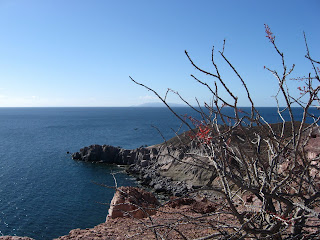

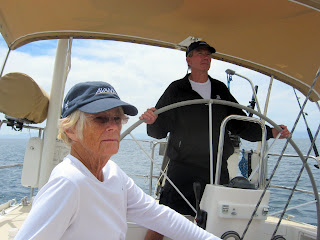
.jpg)
.jpg)

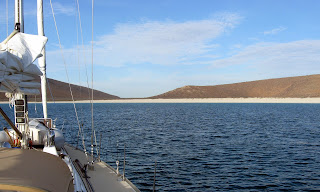
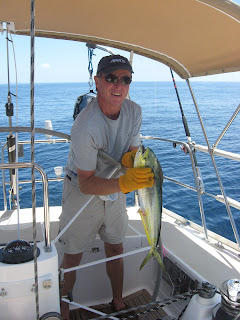
.jpg)















